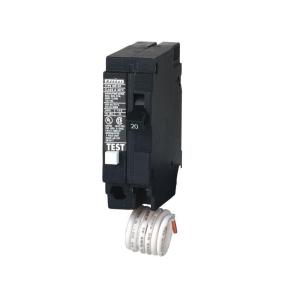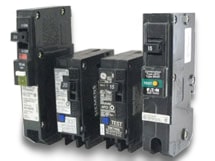Ground Fault and Arc Fault Breakers
What is the Difference Between GFCI vs AFCI Breaker Protection
ARC Electric is Raleigh’s electrician for home wiring, including GFCI/AFCI breaker and outlet installation, that you can count on to provide the highest quality internal wiring in homes and other buildings in Raleigh, at the most affordable prices. ARC Electric proudly serves clients in Raleigh, Durham, and surrounding communities in the triangle area. Whether you are looking for residential, commercial, or industrial electrical service, ARC Electric is the right choice. We offer a full range of electrical services from home circuit breaker panel replacements to wiring up high voltage commercial equipment. Our electricians are trained and equipped to handle any kind of job.

Most people are familiar with GFCI outlets, which are required in many areas of the home in order to help prevent electric shocks. However, you may not be as familiar with AFCI protection. Both GFCI and AFCI circuit breakers provide important safety features for your home, but they work in different ways.
Ground-Fault Circuit-Interrupter Protection (GFCI)
GFCI (Ground Fault Circuit Interrupter) protection outlets and GFCI breaker are designed to protect against ground fault shocks which can cause a fatal electric shock. A ground fault occurs when electricity takes a path through a person instead of through the intended circuit. This can happen if an appliance or cords are damaged and electricity is able to travel through the water or soil and into a person.
How Does a GFCI Outlet Work?
GFCI protection outlets work by constantly monitoring the amount of current flowing through the circuit. If there is a sudden drop in the current flow, it indicates a ground fault, and the outlet trips, interrupting the flow of electricity and preventing a shock.
Where Do I Need A GFCI In My Home?
GFCI protection outlets are required in many areas of the home, such as kitchens, bathrooms, garages, and outdoor outlets. They can be installed as part of a new construction or as a retrofit in older homes to bring them up to code. This is just a small portion of where GFCI protection outlets are required, check with your local building code or electrical inspector for a complete list.


What Type Of GFCIs Are There?
Ground Fault Circuit Interrupters come in two forms, which are pictured above. One is an outlet that has a test and reset button typically found in kitchens, bathrooms, garages, and exterior outlets, the other is in your breaker panel. The GFCI breaker pictured on the right will typically protect exterior circuits that require GFCI protection but do not have an outlet, such as pool equipment. The circuit breakers and outlets do the same task just in different locations in your home. A GFCI will trip when they sense a short to ground by measuring the difference in current between the line and neutral of the circuit. These can prevent electrical shock when water presents an opportunity for a short.
ARC Electric is proud to offer GFCI outlets or a GFCI breaker, the best protection installation as part of our complete line of electrical services. Our certified electricians can install GFCI protection outlets or a GFCI breaker in your home to help keep your family safe.

Arc Fault Circuit Interrupters Protection (AFCI)
The AFCI breaker was adopted by National Fire Protection Association (NFPA) through the National Electrical Code in 1999 in response to a report from the Consumer Product Safety Commission in an effort to prevent fires as an arc can easily ignite the very flammable wood framing and insulation present in most homes. In 2008, the National Electrical Code required AFCI protection on all branch circuits in dining rooms, family rooms, living rooms bedrooms, and other similar spaces. In 2014 kitchens were added to the list. More recently Smoke alarms have been required to be on an AFCI protected circuit. This circuit breaker trips when it senses low or high current arcs that can be caused by damaged wiring or loose connections which can cause fires.
What Causes An Arc Fault?
Vacuum cleaners, mostly (not really, these can also happen at a light switch or any electrical circuit), but if you have noticed that your vacuum cleaner trips an AFCI breaker commonly than you most likely have an arc fault somewhere in the line. An arc fault can be caused by damaged cords, loose connections, or even rodents chewing on electrical wires. When an arc fault occurs, electricity jumps through the air from one conductor to another, creating heat and sparking. This can ignite nearby materials and start a fire.
How Does An AFCI Outlet Work?
AFCI outlets work by constantly monitoring the current flowing through the circuit. If it detects an arc fault, it will trip the breaker and interrupt the flow of electricity, preventing a fire from starting.
Are AFCIs Really Necessary?
While AFCIs are not currently required by code in all areas of the home, they are an important safety feature that is becoming more common. Electrical fires are a leading cause of home fires and having AFCIs is another layer of protection. Many insurance companies offer discounts for homes that have AFCI protection, so it is definitely worth considering for your home.
What Different Type of AFCIs are There?
There are two types of AFCIs, branch circuit/feeder AFCIs and circuit breaker AFCIs. Branch/feeder AFCIs are installed at the first outlet on a circuit and provide protection for the entire branch circuit. Circuit breaker AFCIs are installed in the electrical panel and provide protection for every electrical circuit that is fed by that breaker.
Do I Need an AFCI Added to My Home?

At ARC Electric we highly recommend that if your home was built before the year 2000 check and see if an arc fault circuit interrupter has been installed in your panel. They can be identified by markings on the front and a trip test button also located on the front of the breaker. If your home does not have AFCI breakers you should consider having them installed by a licensed electrician to protect your home and family from potential fires.
GFCI and AFCI Are an Important Part of a Safe Home
GFCI and AFCI outlets and breakers are two important safety features that can help protect your home from electrical fires. GFCI outlets trip when they sense a short to ground, while AFCI outlets trip when they detect an arc fault. Both types of outlets are becoming more common and many insurance companies offer discounts for homes that have them.
When it comes to the safety of your home, you can never be too careful. Having GFCI and AFCI outlets and/or anfci or GFCI breaker installed is a great way to help protect your home from electrical fires. ARC Electric is proud to offer both GFCI and AFCI installation as part of our complete line of electrical services. Our certified electricians can install these outlets in your home to help keep your home and, most importantly, your family safe. Give us a call today to learn more.

